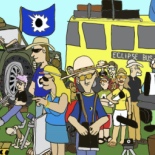 |
www.eclipse-chasers.com Solar Projection Viewing Author: Bill Kramer Last update: Saturday, 18-Apr-2015 11:55:02 EDT |
Eclipse Chaser
(noun) - Anyone that wants to see a total solar eclipse.  Search Eclipse Chasers Site
Search Eclipse Chasers Site |
Projection Viewing
A very safe way to look at the partial phases of a total solar eclipse is to construct a basic pinhole projection. A pinhole projection is the result of light traveling through a small hole and projecting an image of itself against a light colored surface.
You can create a pinhole shield with a piece of paper or cardboard. Poke a hole in paper using a pencil point. The pinhole only needs to be a couple of millimeters across and should be as round as possible. Try not to leave jagged edges if punching the hole through cardboard or some other stiff material.
Pinhole effects can be observed during an eclipse in a variety of places. The shadow through a tree can create a myriad of pinhole images. Loosely woven hats with lots of small holes are a favorite of many eclipse-chasing veterans.
Another interesting technique is to punch several pinholes in the paper so that multiple eclipse images appear on the projected surface. Don't put the holes too close to each other as that will cause the images to overlap.
 The projection technique can also be applied to a telescope or binoculars. That is, an image from the eyepiece can be projected to a surface and the sun studied in detail. Someone very knowledgeable about his or her telescope can do this for you and some small telescopes are sold with solar projection attachments. Under no circumstances should you look through the telescope unless directed so by an expert at solar observing (and make sure there is a solar filter attached in the proper place!).
The projection technique can also be applied to a telescope or binoculars. That is, an image from the eyepiece can be projected to a surface and the sun studied in detail. Someone very knowledgeable about his or her telescope can do this for you and some small telescopes are sold with solar projection attachments. Under no circumstances should you look through the telescope unless directed so by an expert at solar observing (and make sure there is a solar filter attached in the proper place!).
Another nice feature about using a projection technique is that multiple people can view the eclipsed sun at the same time, safely. The image at left shows the projected sun at the beginning of the eclipse in 1972. A 4.25" telescope had a solar screen attached at the projected point from the eyepiece. This allowed multiple people to see the progress of the eclipse without potential damage to their eyes.
When observing a solar eclipse in a group, projections are often a popular stopping point for those wandering about waiting for totality. It is a great opportunity to meet and talk with other eclipse enthusiasts while keeping track of the lunar shadow progress across the disk of the sun. I have set up projections in the past and have enjoyed showing the sun's disk to many casual observers as well as local people who were curious about our expeditions to see the sun go out.
The safest way to observe the partial phases of an eclipse is by using the projection method. It provides a clear view of the sun and does not risk damage to anyone when handled correctly. I advise practicing with the telescope for those just learning how to observe the sun. During the hour (or more) before totality it provides a very entertaining way to track the eclipse progress and meet other interesting eclipse chasers as well as endear yourself to the local populace.
From Richard Bareford: An effective variant to pinhole projection is mirror projection. Basically all that’s involved is replacing the pinhole with a small, flat mirror. The same trigonometry applies. Because the solar diameter is about 30 arc seconds, a ratio of approximately 1/115 (tan 1/2°) will just form an image. That is, the cross section of the mirror or pinhole must be no greater than 1/115 of the projection distance. Generally, the smaller this ratio the better is the result. The mirror image is not as sharp as when using a lens, but there are two distinct advantages over the pinhole method. The image can be easily reflected unto a shadowed wall, greatly improving visibility; and, it can be projected much farther producing a larger image. The trade-off is that while the image is larger and sharper, it also becomes dimmer. Mirror projection can occur accidentally as when the reflections from a skyscraper’s windows create myriad solar images on the ground and neighboring buildings. On my website I show an example of a deliberate mirror projection of the 1994 annular eclipse.
